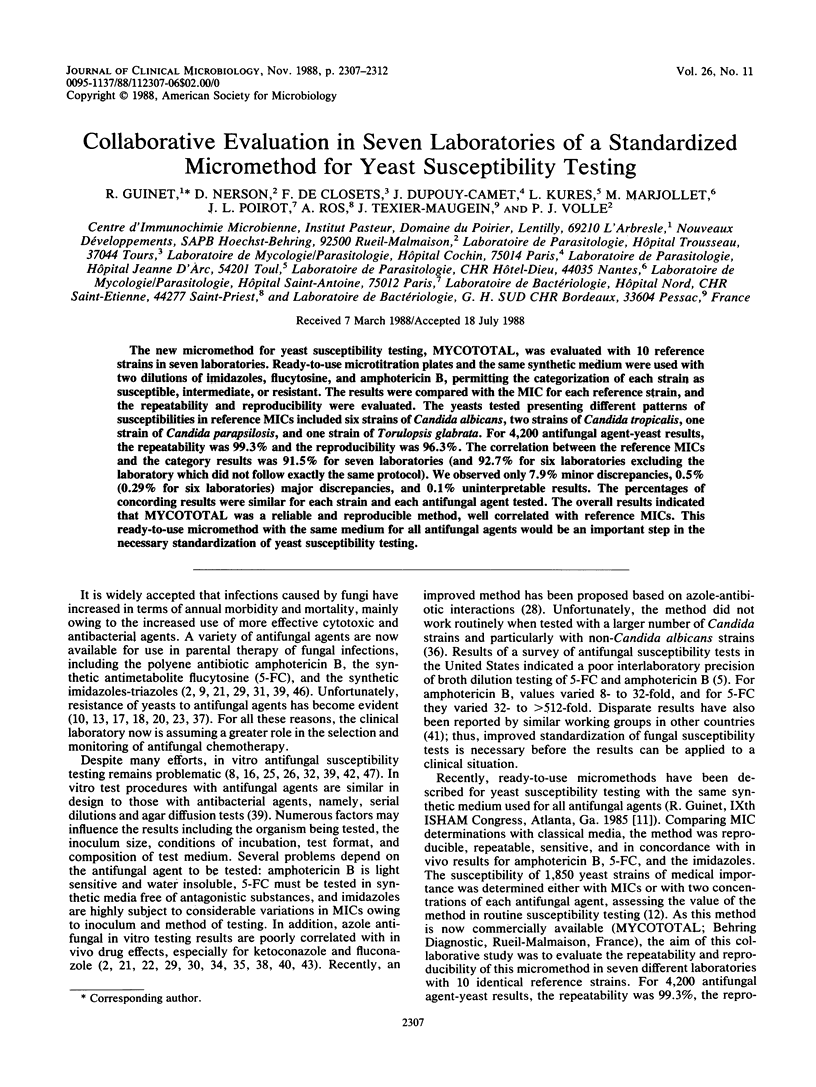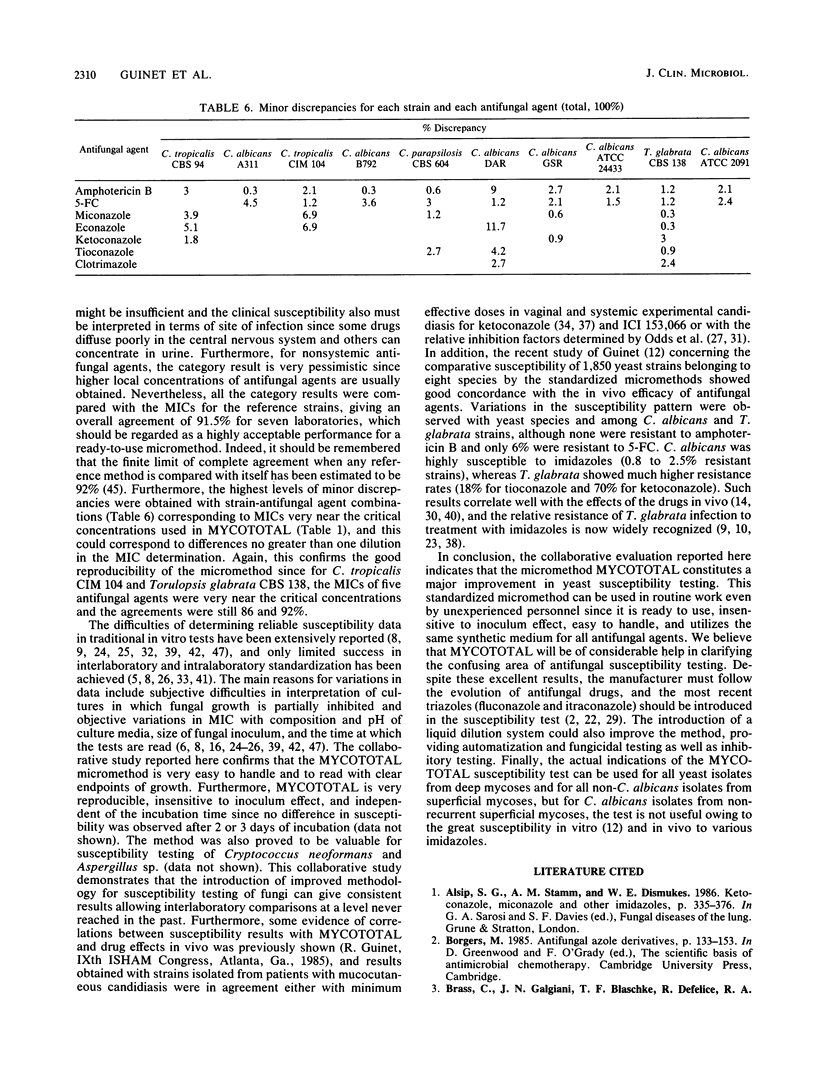Abstract
The new micromethod for yeast susceptibility testing, MYCOTOTAL, was evaluated with 10 reference strains in seven laboratories. Ready-to-use microtitration plates and the same synthetic medium were used with two dilutions of imidazoles, flucytosine, and amphotericin B, permitting the categorization of each strain as susceptible, intermediate, or resistant. The results were compared with the MIC for each reference strain, and the repeatability and reproducibility were evaluated. The yeasts tested presenting different patterns of susceptibilities in reference MICs included six strains of Candida albicans, two strains of Candida tropicalis, one strain of Candida parapsilosis, and one strain of Torulopsis glabrata. For 4,200 antifungal agent-yeast results, the repeatability was 99.3% and the reproducibility was 96.3%. The correlation between the reference MICs and the category results was 91.5% for seven laboratories (and 92.7% for six laboratories excluding the laboratory which did not follow exactly the same protocol). We observed only 7.9% minor discrepancies, 0.5% (0.29% for six laboratories) major discrepancies, and 0.1% uninterpretable results. The percentages of concording results were similar for each strain and each antifungal agent tested. The overall results indicated that MYCOTOTAL was a reliable and reproducible method, well correlated with reference MICs. This ready-to-use micromethod with the same medium for all antifungal agents would be an important step in the necessary standardization of yeast susceptibility testing.
Full text
PDF





Selected References
These references are in PubMed. This may not be the complete list of references from this article.
- Brass C., Galgiani J. N., Blaschke T. F., Defelice R., O'Reilly R. A., Stevens D. A. Disposition of ketoconazole, an oral antifungal, in humans. Antimicrob Agents Chemother. 1982 Jan;21(1):151–158. doi: 10.1128/aac.21.1.151. [DOI] [PMC free article] [PubMed] [Google Scholar]
- Burgess M. A., Bodey G. P. Clotrimazole (Bay b 5097): in vitro and clinical pharmacological studies. Antimicrob Agents Chemother. 1972 Dec;2(6):423–426. doi: 10.1128/aac.2.6.423. [DOI] [PMC free article] [PubMed] [Google Scholar]
- Doern G. V., Tubert T. A., Chapin K., Rinaldi M. G. Effect of medium composition on results of macrobroth dilution antifungal susceptibility testing of yeasts. J Clin Microbiol. 1986 Oct;24(4):507–511. doi: 10.1128/jcm.24.4.507-511.1986. [DOI] [PMC free article] [PubMed] [Google Scholar]
- Drouhet E., Dupont B. Preliminary studies on the pharmacology and therapeutic activity of oral and intravenous econazole. Mykosen Suppl. 1978;1:192–201. [PubMed] [Google Scholar]
- Drutz D. J. In vitro antifungal susceptibility testing and measurement of levels of antifungal agents in body fluids. Rev Infect Dis. 1987 Mar-Apr;9(2):392–397. doi: 10.1093/clinids/9.2.392. [DOI] [PubMed] [Google Scholar]
- Graybill J. R., Craven P. C. Antifungal agents used in systemic mycoses. Activity and therapeutic use. Drugs. 1983 Jan;25(1):41–62. doi: 10.2165/00003495-198325010-00003. [DOI] [PubMed] [Google Scholar]
- Graybill J. R., Galgiani J. N., Jorgensen J. H., Strandberg D. A. Ketoconazole therapy for fungal urinary tract infections. J Urol. 1983 Jan;129(1):68–70. doi: 10.1016/s0022-5347(17)51922-9. [DOI] [PubMed] [Google Scholar]
- Guinet R., Chanas J., Goullier A., Bonnefoy G., Ambroise-Thomas P. Fatal septicemia due to amphotericin B-resistant Candida lusitaniae. J Clin Microbiol. 1983 Aug;18(2):443–444. doi: 10.1128/jcm.18.2.443-444.1983. [DOI] [PMC free article] [PubMed] [Google Scholar]
- Guinet R. Sensibilité comparée des levures aux antifongiques en microméthode standardisée. Pathol Biol (Paris) 1986 May;34(5):536–539. [PubMed] [Google Scholar]
- Heel R. C., Brogden R. N., Carmine A., Morley P. A., Speight T. M., Avery G. S. Ketoconazole: a review of its therapeutic efficacy in superficial and systemic fungal infections. Drugs. 1982 Jan-Feb;23(1-2):1–36. doi: 10.2165/00003495-198223010-00001. [DOI] [PubMed] [Google Scholar]
- Heel R. C., Brogden R. N., Pakes G. E., Speight T. M., Avery G. S. Miconazole: a preliminary review of its therapeutic efficacy in systemic fungal infections. Drugs. 1980 Jan;19(1):7–30. doi: 10.2165/00003495-198019010-00002. [DOI] [PubMed] [Google Scholar]
- Hoeprich P. D., Merry J. M. Influence of culture medium on susceptibility testing with BAY n 7133 and ketoconazole. J Clin Microbiol. 1986 Aug;24(2):269–271. doi: 10.1128/jcm.24.2.269-271.1986. [DOI] [PMC free article] [PubMed] [Google Scholar]
- Holt R. J., Azmi A. Miconazole-resistant Candida. Lancet. 1978 Jan 7;1(8054):50–51. doi: 10.1016/s0140-6736(78)90403-8. [DOI] [PubMed] [Google Scholar]
- Jevons S., Gymer G. E., Brammer K. W., Cox D. A., Leeming M. R. Antifungal activity of tioconazole (UK-20,349), a new imidazole derivative. Antimicrob Agents Chemother. 1979 Apr;15(4):597–602. doi: 10.1128/aac.15.4.597. [DOI] [PMC free article] [PubMed] [Google Scholar]
- Johnson E. M., Richardson M. D., Warnock D. W. In-vitro resistance to imidazole antifungals in Candida albicans. J Antimicrob Chemother. 1984 Jun;13(6):547–558. doi: 10.1093/jac/13.6.547. [DOI] [PubMed] [Google Scholar]
- Lefler E., Stevens D. A. New azole compounds: vibunazole (Bay n7133) and Bay L9139, compared with ketoconazole in the therapy of systemic candidosis and in pharmacokinetic studies, in mice. J Antimicrob Chemother. 1985 Jan;15(1):69–75. doi: 10.1093/jac/15.1.69. [DOI] [PubMed] [Google Scholar]
- Meunier F. Prevention and mycoses in immunocompromised patients. Rev Infect Dis. 1987 Mar-Apr;9(2):408–416. doi: 10.1093/clinids/9.2.408. [DOI] [PubMed] [Google Scholar]
- Odds F. C., Abbott A. B., Pye G., Troke P. F. Improved method for estimation of azole antifungal inhibitory concentrations against Candida species, based on azole/antibiotic interactions. J Med Vet Mycol. 1986 Aug;24(4):305–311. doi: 10.1080/02681218680000461. [DOI] [PubMed] [Google Scholar]
- Odds F. C., Abbott A. B. Relative inhibition factors--a novel approach to the assessment of antifungal antibiotics in vitro. J Antimicrob Chemother. 1984 Jan;13(1):31–43. doi: 10.1093/jac/13.1.31. [DOI] [PubMed] [Google Scholar]
- Odds F. C., Cheesman S. L., Abbott A. B. Antifungal effects of fluconazole (UK 49858), a new triazole antifungal, in vitro. J Antimicrob Chemother. 1986 Oct;18(4):473–478. doi: 10.1093/jac/18.4.473. [DOI] [PubMed] [Google Scholar]
- Odds F. C. Laboratory evaluation of antifungal agents: a comparative study of five imidazole derivatives of clinical importance. J Antimicrob Chemother. 1980 Nov;6(6):749–761. doi: 10.1093/jac/6.6.749. [DOI] [PubMed] [Google Scholar]
- Odds F. C., Milne L. J., Gentles J. C., Ball E. H. The activity in vitro and in vivo of a new imidazole antifungal, ketoconazole. J Antimicrob Chemother. 1980 Jan;6(1):97–104. doi: 10.1093/jac/6.1.97. [DOI] [PubMed] [Google Scholar]
- Odds F. C., Webster C. E., Abbott A. B. Antifungal relative inhibition factors: BAY l-9139, bifonazole, butoconazole, isoconazole, itraconazole (R 51211), oxiconazole, Ro 14-4767/002, sulconazole, terconazole and vibunazole (BAY n-7133) compared in vitro with nine established antifungal agents. J Antimicrob Chemother. 1984 Aug;14(2):105–114. doi: 10.1093/jac/14.2.105. [DOI] [PubMed] [Google Scholar]
- Plempel M., Berg D., Büchel K. H., Abbink D. Test methods for antifungal agents--a critical review. Mykosen. 1987 Jan;30(1):28–37. [PubMed] [Google Scholar]
- Polak A. Multicenter-Studie zur Standardisierung der Empfindlichkeitsbestimmung von Pilzen gegen 5-Fluorcytosin und Amphotericin B. Mykosen. 1987 Jul;30(7):306-8, 311-4. [PubMed] [Google Scholar]
- Polak A., Odds F. C., Lüdin E., Scholer H. J. Correlation of susceptibility test results in vitro with response in vivo: ketoconazole therapy in a systemic candidiasis model. Chemotherapy. 1985;31(5):395–404. doi: 10.1159/000238365. [DOI] [PubMed] [Google Scholar]
- Polak A., Scholer H. J., Wall M. Combination therapy of experimental candidiasis, cryptococcosis and aspergillosis in mice. Chemotherapy. 1982;28(6):461–479. doi: 10.1159/000238138. [DOI] [PubMed] [Google Scholar]
- Ryley J. F., Wilson R. G., Barrett-Bee K. J. Azole resistance in Candida albicans. Sabouraudia. 1984;22(1):53–63. [PubMed] [Google Scholar]
- Sobel J. D., Muller G. Ketoconazole in the prevention of experimental candidal vaginitis. Antimicrob Agents Chemother. 1984 Feb;25(2):281–282. doi: 10.1128/aac.25.2.281. [DOI] [PMC free article] [PubMed] [Google Scholar]
- Stevens D. A. Antifungal drug susceptibility testing. A critical review. Mycopathologia. 1984 Sep 30;87(3):135–140. doi: 10.1007/BF00436898. [DOI] [PubMed] [Google Scholar]
- Symoens J., Moens M., Dom J., Scheijgrond H., Dony J., Schuermans V., Legendre R., Finestine N. An evaluation of two years of clinical experience with ketoconazole. Rev Infect Dis. 1980 Jul-Aug;2(4):674–687. doi: 10.1093/clinids/2.4.674. [DOI] [PubMed] [Google Scholar]
- Thornsberry C., Gavan T. L., Sherris J. C., Balows A., Matsen J. M., Sabath L. D., Schoenknecht F., Thrupp L. D., Washington J. A., 2nd Laboratory evaluation of a rapid, automatic susceptibility testing system: report of a collaborative study. Antimicrob Agents Chemother. 1975 Apr;7(4):466–480. doi: 10.1128/aac.7.4.466. [DOI] [PMC free article] [PubMed] [Google Scholar]


